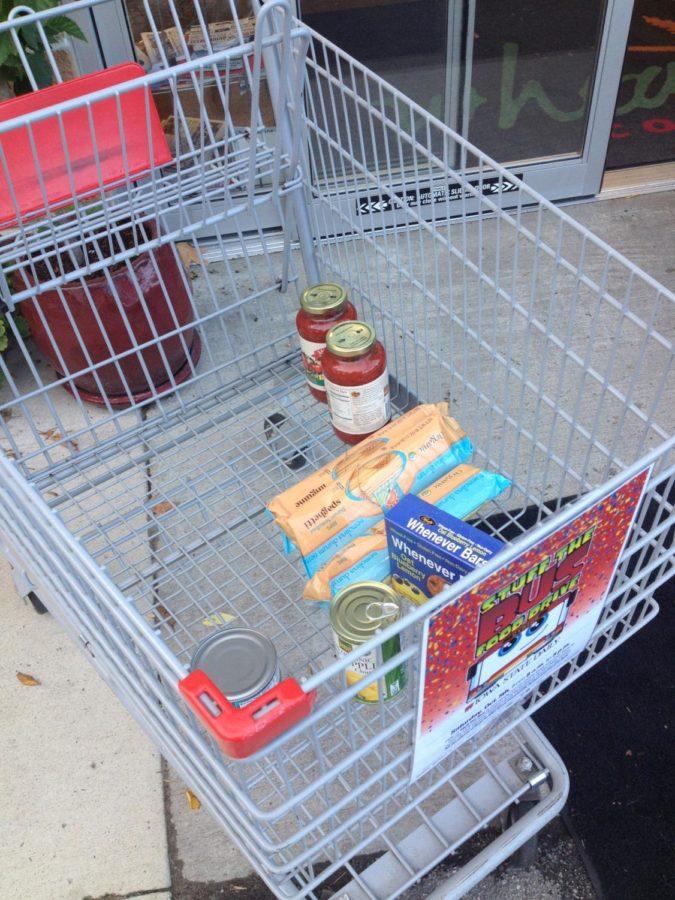Wandschneider: Food for thought: CyServe, donations, goodwill
Hayley Bookey/Iowa State Daily
Volunteering with local food banks and donating food items is just one way students can give back to their community without breaking the bank. Students and community members got involved with Stuff the Bus day on Saturday to serve worthy causes in Ames.
October 7, 2013
On Oct. 5, I was given a wonderful opportunity to participate in CyServe Day, a chance for ISU students to volunteer around the Ames community. It really shows the values of the community by having a day that involves volunteering for many worthy causes.
The cause I volunteered for was Stuff the Bus, an event involving food collection for local food banks. The goal was to have each of the stationed CyRide buses filled with donations by the end of the day. Volunteers were stationed outside of grocery stores, instructed to hand out wish lists to try and get customers to donate.
It was amazing to see the generosity — and that complete strangers were willing to donate so much, from a small jar of peanut butter to an entire cart full of assorted food items. I even got a chance to shop around to donate to such a worthy cause myself.
Seeing the amount of food we collected from just one location was indescribable. Knowing that I helped make a difference made the multiple hours of standing outside completely worth it.
This experience made me remember something we ignore too often — the importance of supporting local food banks.
It’s easy to walk into the dining center and complain to your friends about having nothing to eat, while in reality, there is a variety of food to choose from. It just might not be what you are in the mood for that day.
We take the dining centers for granted and often use this phrase without thinking that there are people out there who actually use the term for it’s true meaning — there is no food. It isn’t that we are selfish people; it’s simply something we take for granted.
Approximately one in six Americans know what it feels like to go hungry. It’s difficult to wrap our minds around the fact that about 70 million American households experience food insecurity; they don’t know when or if they will be able to get enough food on a given day.
Food security is a real problem in this country, and this is where food banks steps in.
Food banks are charitable organizations that receive donated food items and sell them at a much lower price to people in need, sort of like discount grocery stores. Last year, 6.2 million American households received some kind of help from a food bank.
During the holiday season, it is common for many schools, businesses and organizations to host food drives; the holidays spark interest in donations because holidays are occasions for large, elegant meals.
Now this is valid. There is a high demand for donations during the holidays, but after they are over, it’s almost like people forget that there is still a need for food donations.
Food banks are constantly open to both customers and donors. By donating to a food bank, you are giving someone a chance to purchase their next meal at a price affordable to them.
You don’t have to wait to for a community food drive in order to donate. You can start right now, with any extra food in your pantry. Summer months are when food banks are experiencing the greatest demand, when kids are done with school, eating all of their meals at home. This puts so much more stress on families.
Donations don’t even have to have brand names; generic brands are just as good and don’t involve a large amount of extra spending on your part.
A common concern for some people is that they can barely afford food for themselves, let alone for food bank donations. But donating isn’t the only way to help a food bank; volunteers are needed to help stock shelves and cross off bar codes on the donated items. It’s a simple way to give back to a community and to help others who aren’t as fortunate as some.
Some may argue that people take advantage of food bank services when they are financially capable of shopping at Walmart or Target for their groceries.But that isn’t the point.
The point is to provide a service to a community and the people residing within it. It is our job as members of this community to help support those who aren’t as fortunate as we are.







